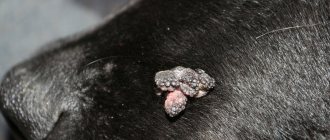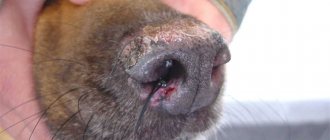Pets get sick quite often. Unfortunately, they are also susceptible to various infections that are sexually transmitted. One of these diseases is transmissible sarcoma in dogs . In dogs, this pathology in advanced cases leads to death.
.
Therefore, owners should take the health of their pets more seriously and not forget about preventive measures. To avoid the appearance of a tumor such as venereal sarcoma in dogs , it is necessary to carefully choose partners for the animal.
Venereal sarcoma in dogs: probable causes
Carrying out various studies, scientists have found that venereal sarcoma is transmitted through sexual contact between two individuals. In more detail, during sexual intercourse, infected histiocidal macrophage cells become active and penetrate the body of a healthy individual, thereby infecting it. The heroes of the occasion are the tumor cells that carry the infection. They penetrate into soft tissues and begin to successfully multiply there and progress in development. If your pet is infected with sarcoma, even the composition of its chromosomes will change
. Nature initially prescribes the presence of 78 chromosomes, but as the disease progresses, their number decreases significantly and can amount to 58-65 chromosomes. This is a very significant difference.
There is another interesting point on which representatives of veterinary medicine disagree. This is the presence of metastases when transmissible sarcoma appears in dogs . Some doctors believe that sarcoma does not metastasize, and they explain the tumors that appear in the mouth and nose of animals by the interaction of the dog with its genitals when washing and various movements. Their appearance is characterized by the transfer and introduction of infected cells into other parts of the body with which they interact. The other half of the scientific doctors believe that the appearance of metastases is due to the progression of the disease in the animal’s body, and argue that in some cases tumors can be observed not only in the oral cavity, but also in internal organs, such as the spleen, liver, brain, muscle tissue, etc. .d.
What is venereal sarcoma in dogs?
Transmissible venereal sarcoma is a neoplasm that develops primarily on the dog's genitals. The disease arose about eleven thousand years ago and during this time accumulated about two million mutations. This is a unique pathology that combines the features of infectious and oncological diseases.
Venereal sarcoma has been studied for over a hundred years. Most doctors classify vensarcoma as an infectious disease with a malignant course. Some experts consider cancer cells to be a kind of parasites, since they are able to develop in any favorable environment, changing their location. We can say that a cancer cell behaves like an infectious agent, penetrating into healthy mucosa.
There are several stages in the development of venous sarcoma in dogs:
- First stage. It is characterized by tumor growth in the superficial tissues of the organ and the absence of metastases. For the most part it is small in size - up to three centimeters.
- Second stage. The tumor grows (increases to 5-6 cm), penetrates deeper into the organ tissue, and is mobile when palpated. Metastasis may be detected in one of the lymph nodes.
- Third stage. The tumor enlarges, is motionless on palpation, and multiple metastases are found in the lymph nodes.
- Fourth stage. The tumor extends beyond the organ. Metastases appear in the liver, lungs, and kidneys.
The conclusion suggests itself: the sooner a sick dog gets examined by a veterinarian and receives the necessary treatment, the greater his chances of a successful recovery.
Veterinary clinic of Dr. Shubin
Incidence and risk factors
Canine venereal sarcoma is an infectious histiocytic tumor of dogs, transmitted through close contact between animals.
The tumor was first described in 1876, and at the same time a successful attempt was made to transplant tumor cells from one animal to another. It is believed that SVD first appeared about 10,000-15,000 years ago among inbred dogs or wolves, at about the same time the first domestication of dogs occurred. It mainly affects domestic dogs, but is sometimes observed in other canids such as foxes, coyotes and jackals. Transmissible venereal sarcoma is distributed throughout the world, but is more common in tropical and subtropical regions. The incidence of venereal sarcoma is increased in areas with a large number of stray, sexually active dogs. The disease can occur in animals of any age, gender and sexual status, but most often young, free-roaming animals with pronounced sexual activity are affected.
Synonyms: canine transmissible venereal tumor, Sticker's sarcoma, canine transmissible venereal sarcoma, canine venereal granuloma, canine condyloma, canine transmissible lymphosarcoma.
Biology and Behavior
The process of transmission of tumor cells most often occurs during coitus, but transmission is also likely through licking, sniffing and biting the area affected by the tumor. The process of tumor transfer from animal to animal consists of moving a transmissible tumor allograft through the main barrier of the histocompatibility complex through transplantation of viable tumor cells into the damaged mucous membrane during close contact of animals (eg coitus, licking, sniffing, biting). The external genitalia are most often affected, but venereal sarcoma is likely to develop in the mucous membranes of the oral and nasal cavities, eyes, and subcutaneous tissues. Extragenital lesions can be observed either separately or together with lesions of the genitals, but in most cases lesions are still found on the genitals.
The tumor develops on average within 2-6 months from the moment of inoculation of cells into the mucosa, but the growth rate is subject to significant differences - from rapid invasive growth with metastasis, to slow, unpredictable growth over several years. Spontaneous regression of the tumor is observed within 3 to 6 months after implantation of tumor cells, but in cases where the tumor persists for more than 9 months, the chances of spontaneous regression are significantly reduced.
The growth of venereal sarcoma in healthy animals is localized, but in 5%-17% of cases there is metastasis to regional lymph nodes (eg inguinal and iliac lymph nodes, tonsils), subcutaneous tissues, skin, eyes, oral mucosa, liver, spleen, peritoneum, pituitary gland, brain and bone marrow. Due to the fact that the tumor is transmitted by licking, sniffing and biting, it is difficult to distinguish true metastasis from growth due to mechanical spread.
Canine venereal sarcoma is an immunogenic tumor, and it is the animal's immune response that plays a critical role in the biological behavior of the tumor. The course of the disease is conventionally divided into three phases; progressive phase, in which tumor growth is observed over 3-6 months; short stable phase; regressive phase. The regression phase may be absent in dogs with an impaired immune response.
Clinical signs
Primary lesions are usually localized on the external genitalia. In male dogs, venereal sarcoma is usually localized in the caudal part of the penis and its visualization requires complete displacement of the prepuce and exposure of the penis; in rare cases, the tumor is localized on the prepuce. In bitches, sarcoma is more often localized in the distal areas of the vagina and its vestibule. At the beginning of the disease, the tumor consists of small (1-3 mm) hyperemic papules, with the progress of tumor growth, the papules grow together and form nodular, papillary, multilobular formations in the form of cauliflower up to 10-15 cm in size, the formation of a stalk is likely. The masses are hard but very fragile, with an ulcerated and inflamed surface, serous-hemorrhagic or hemorrhagic discharges are characteristic.
Clinical signs may vary depending on the location of the lesion. Genital lesions manifest as chronic signs of discomfort or hemorrhagic discharge from the prepuce or vulva; with a significant amount of bleeding, anemia of blood loss is likely to develop. The lesions may predispose to lower urinary tract infection but are rarely associated with dysuria. Extragenital lesions cause various symptoms depending on the specific anatomical location - sneezing, epistaxis, halitosis, tooth loss, exophthalmos, skin masses, facial deformation and enlarged lymph nodes, etc.
The incidence of metastasis is approximately 15%, but because diagnostic staging is not performed in most cases, the true incidence of metastasis may be higher. When examining an animal with venereal sarcoma, it is optimal to examine regional lymph nodes (palpation, if enlarged, fine-needle biopsy), a thorough physical examination to identify possible lesions outside the genital organs, and, if necessary, radiographic and ultrasound examinations.
A general blood test can reveal moderate erythrocytosis as a paraneoplastic syndrome, which sometimes requires temporary symptomatic therapy. Other laboratory parameters for venereal sarcoma are usually within normal limits.
Diagnostics
A presumptive diagnosis with a high degree of probability is established on the basis of the characteristic clinical manifestations of the tumor; the final diagnosis is easily confirmed by cytological examination; histopathological examination is carried out in exceptional cases.
The cytological picture is characterized by a homogeneous population of discrete round or polyhedral (polyhedral) cells with pronounced pale blue cytoplasm and eccentrically located nuclei; sometimes binucleate cells and mitotic figures are noted. The most characteristic feature is multiple discrete clear cytoplasmic vacuoles. Single or multiple nucleoli surrounded by clumpy chromatin are often observed. In the phase of tumor regression, the cytological picture is characterized by the content of a large number of lymphocytes.
The list of differential cytological diagnoses should include such neoplasms as lymphoma, plasmacytoma, mastocytoma, histiocytoma and amelanotic melanoma, but differentiation is not difficult for an experienced cytologist.
Treatment
Canine transmissible venereal sarcoma responds best to chemotherapy treatments. Monotherapy with vincristine at a dose of 0.5-0.7 mg/m2, intravenously, once a week, 3-6 injections leads to a complete cure in 90%-95% of animals. Resistant cases respond to therapy with DOX at a dose of 25-30 mg/m2, IV, every three weeks, 3 injections. In cases where chemotherapy treatments are not effective, radiation is likely to be used, to which venereal sarcoma is also sensitive.
Surgical treatment can be quite effective in cases of small and localized tumors, but tumor recurrence is observed in 30%-75% of cases of tumor excision due to mucosal trauma and secondary tumor cell transplantation.
Other therapies may include biologic response modification, piroxicam therapy, cryosurgery, radiofrequency ablation, laser ablation, and electrochemotherapy.
Forecasts
The prognosis for canine transmissible venereal sarcoma is generally favorable; in most healthy dogs, tumor growth is localized, spontaneously regresses, and responds well to chemotherapy treatment. In exceptional cases, the prognosis may be unfavorable; this phenomenon is observed in animals with severely impaired immune response.
Photo 1. A 10-year-old mongrel female at an appointment at a veterinary clinic, about a month ago she ran away during estrus. The owners contacted the clinic regarding bloody discharge from the vagina. Upon examination and palpation, masses protruding from the vagina were revealed.
Photo 2. A close-up view of the masses protruding from the vagina of the same dog.
Photo 3. Photo of a cytological sample obtained at a veterinary clinic from this dog through a fine-needle biopsy. The smear revealed multiple, vacuolated, discrete cells with a round nucleus, typical of a tumor. Giemsa-Romanowsky stain, magnification 1000x
Photo 4 . Transmissible venereal sarcoma in a 13-year-old male German shepherd at an appointment at a veterinary clinic (cytologically confirmed)
Valery Shubin, veterinarian, Balakovo
Causes of vensarcoma in dogs
As warm days approach, dogs' sexual instinct awakens. Many owners take their charges out into nature, to the country, where they condone the random mating of their pets, stunned by the rampage of hormones.
It is with the onset of the first thaw that veterinary clinics are filled with four-legged patients with suspected venereal sarcoma. Alas, most of these diagnoses are confirmed.
Mostly, owners are very surprised to learn that dogs also have sexually transmitted diseases. However, some of them refuse to admit the mistakes that led to the infection of their beloved dog.
Transmissible venereal sarcoma in dogs occurs when tumor cells enter the body, which occurs during sexual contact with a sick individual. The disease is very insidious, as it has a long incubation period - from 1 to 8 months. At this time, there are no symptoms, but the dog can already transmit vensarcoma to other animals.
The most common causes of venereal sarcoma are:
- promiscuous sexual contact, in particular with stray animals;
- weak immunity;
- lack of preventive measures to combat the disease;
- untimely medical care, late diagnosis.
Clinical picture
How can you understand that your pet has vensarcoma, and what symptoms develop? appear on the penis or vulva , but there are many of them from the very first days. Soon (sarcoma is a type of very aggressive cancer), they become inflamed, begin to bleed, and a severe pain reaction occurs. Let us emphasize once again that sarcoma is one of the most terrible and aggressive types of cancer. Within a few weeks, the same nodules may appear on other parts of the body, and that’s the end.
Note that tumors grow quickly only at first, but subsequently remain static (from a couple of weeks to several months). Despite all of the above, vensarcoma in dogs often disappears spontaneously. This is due to the fact that the body of a young and physically strong animal can begin to produce antibodies, as a result of which the tumors will resolve. But you shouldn’t particularly hope for this, since this is still an oncological pathology, and prone to the development of metastases and rapid spread throughout the body.
Dog breeds with a high propensity for the disease
All males and females have a high probability of contracting this unpleasant disease, and among all registered cases, 71% of cases are females, and the remaining 29% are males. The breed plays practically no role, however, experts still distinguish several types:
- chow-chow;
- bull terrier;
- poodle;
- Airedale;
- shepherd dog
Of course, domestic dogs are less susceptible to this disease, although huskies, greyhounds, and hounds, which lead a fairly free pack lifestyle, are definitely at risk.
The disease poses a particular danger to breeding producers. Such dogs must have excellent health, because they are capable of transmitting the disease to a huge number of other animals. And puppies that have just been born and have not even managed to get close to the onset of puberty can contract venereal sarcoma from their carrier mother.
Diagnostic nuances
When studying the clinical picture, the initial task of the veterinarian is to differentiate the specific type of sarcoma. In males, venereal oncology can be confused with prostatitis at some stages, and in females - with pyometric disease.
The most important diagnostic points are determining the localization of the tumor process and searching for tumor nodes. New growths are loose and soft. The structure is easily damaged, causing bleeding.
Symptoms of the disease
In the early stages, venereal sarcoma is hardly noticeable. Only a truly caring and attentive owner will notice restless behavior that is unusual for the pet, and an increased urge to urinate. Usually dogs begin to lick the area that bothers them.
The symptoms of the disease are quite specific:
- bloody discharge from the vagina or prepuce;
- urinary retention;
- lumpy formations on the outside of the genitals, resembling cauliflower;
- protrusion of the perineum.
If tumor cells enter the muzzle area, although most often the disease affects the genitals, the following may occur:
- cabbage-shaped neoplasm in the mouth;
- difficulty breathing, sneezing;
- nosebleeds;
- enlargement of the submandibular lymph nodes;
- swelling of the muzzle.
Treatment of the disease
The treatment method is selected based solely on the stage of the disease:
Initial stage . The tumor grows only on the superficial layer and is no more than 30 mm, with no metastases;
Second stage . The neoplasm reaches a size of 50-60 mm, and now begins to grow into the deep tissues of the genital organ. Metastases may appear, but they are minor; An even greater increase in the growth leads to its extension beyond the genital organ. At this stage, large metastases are observed in the lymph nodes. The tumor grows to such a size that it can completely block the lumen of the vagina. In this case, the urinary channel is not accessible even after opening the organ. It will not be possible to do without a catheter, therefore, at the stage of preparation for the operation, a catheter is inserted into the lumen;
Launched stage . The tumor spreads to adjacent organs and metastasizes to the body’s filtering systems (kidneys and liver), as well as to various parts of the body.
Treatment options
There are 2 main areas of treatment for the disease:
Conservative treatment involves therapy without surgical intervention. This includes chemotherapy. It is prescribed only in extreme cases when the operation is unacceptable. Due to the high toxicity and severity of the impact on the animal’s body, this method is not preferable;
Surgical treatment is a method that leads to the complete elimination of the growth until only healthy tissue remains. The prognosis is quite favorable, but bleeding may complicate the surgical procedure.
Important! In particularly advanced cases, the genital organ can be completely removed, and the urethra is transferred into the abdominal wall through a catheter. This practice occurs only in extremely severe forms.
After removing the pathogenic tissue, a three-layer suture is applied to the perineum, which allows the tissue to recover. Unfortunately, surgery cannot help in some cases when the disease was discovered extremely late.
What are the features of the technique: It is important to eliminate the tumor completely. If even a small part remains, there is a risk of recurrence of sarcoma. Also, metastases are removed from lymph nodes and glands; sometimes even an organ has to be removed;
- Treatment with surgery can be supplemented with the simultaneous action of immunostimulating drugs on the body, which increase the effectiveness of the protective reaction;
- The tumor tissue must not be damaged during the operation, otherwise the cells will spread throughout the body;
- During the operation, several sterilization cycles are required to avoid introducing pathological cells into the dog’s body;
- Throughout the procedure, you need to monitor the appearance of bleeding and stop it in a timely manner.
- Anesthesia is used to perform the operation; in simpler cases, local anesthesia can be used.
Treatment of venereal sarcoma in dogs in veterinary clinics
The treatment method should be selected by a qualified doctor. Today there are two ways to get rid of this problem:
- Conservative treatment. This refers to therapy without surgery, or more precisely, chemotherapy. This type of treatment is used only in extreme cases when surgery is impossible for a number of reasons. Chemotherapy is very toxic and causes great harm to the patient’s body, which is why this method is considered exceptional.
- Surgical treatment. The most common method in the fight against venereal sarcoma. The tumor is completely excised and, as a rule, the results of this procedure are very positive; however, sudden bleeding can complicate the operation. Usually, after surgery, the veterinarian prescribes auxiliary medications. These may be anti-inflammatory or immunomodulatory agents.
Please note that in severely advanced cases, the dog’s genital organ can be completely removed, and instead of the urethra, a catheter will be placed into the abdominal cavity. If time was lost and the owner sought help too late, unfortunately, even surgery will not save the dying animal.
How to prevent canine condyloma?
The most effective measure that will help prevent the occurrence of a tumor in a pet is the attentiveness and caution of its owners. To prevent the formation of a transmissible venereal tumor, dogs should not be allowed to walk alone. On top of that, the owner should not allow, much less approve, random matings of the animal.
Even when pairing your dog with a proven and purebred individual of the opposite sex, you must ask the owner whether his pet has had sexual contact with casual partners. If the answer is positive, you should refuse mating.
If you still cannot protect your pet from contact with a stray dog, it is better to take appropriate measures. It is imperative to disinfect the dog’s genitals and mouth with furatsilin, potassium permanganate or iodinol. If clinical signs of the disease appear, you should immediately contact a veterinarian.
In general, the prevention of this disease is a public matter. To reduce cases of infection, it is necessary to reduce the number of stray animals within one locality by sterilization. In addition, veterinary control must be carried out.
Prevention and prognosis of venereal sarcoma
Preventive measures can be:
- monitoring the reproductive cycles of bitches throughout their lives;
- before mating and a month after it, clinical examination of the genital organs of animals;
- treatment after mating of the genitals with disinfectants;
- do not breed the animal with dogs infected with venereal sarcoma;
- use a rational type of feeding depending on the breed, age and energy costs and good maintenance;
- take the dog out into the fresh air more often, giving it the opportunity to fully move;
- caution and attentiveness of the owners;
- preventing indiscriminate matings between a pet and a dog that has had random partners;
- veterinary access control;
- sterilization or castration of a dog.
Important. These measures will eliminate sexual contact and save the animal not only from the possibility of contracting sarcoma, but also from more dangerous cancers.
The responsibility of owners in preventing VS matters not only for their own dog, but also for the four-legged inhabitants of the region and city, and has consequences for society.
Types of sarcoma disease:
Connective tissue is present in all organs of the animal. The classification is based on the principle of tumor localization and the system affected by the pathological process.
The following types of carcinomas are distinguished:
- Sarcoma of the mammary gland in a dog develops in the absence of proper treatment for mastitis.
- Transmissible or venereal sarcoma in dogs is sexually transmitted, accompanied by an inflammatory process and contains atypical cells.
- Bone – affects the organs of the musculoskeletal system. Frequent diagnoses are sarcoma of the dog's jaw, bone structures, and joints.
- Lymphatic – the lymphatic system is affected. An aggressive type of tumor, since metastasis occurs through the lymphogenous route.
- Soft tissue sarcoma in dogs is the least studied type. It is believed that the cause of tumor development is metastasis from other organs and systems.
Classification of sarcoma:
Sarcoma in dogs when cut looks like fish meat. The color is white-pink. When classifying tumors, the size of the tumor and its effect on other tissues are taken into account. Sarcoma in dogs at the first stage does not exceed 3 cm. Carcinoma is located on the surface of the organ. In the second stage , the size of the tumor increases, and mutated cells begin to invade the organ.
In the third case , the carcinoma has affected the organ completely and extends beyond its boundaries. The disease at this stage affects the nearest lymphatic collectors. Secondary tumors appear.
At the fourth stage, mutated cells are found in all organs and systems of the animal.











